
Dolphins are aquatic mammals found in warm and cold waters. Most species live in saltwater, but the Ganges river dolphin lives in freshwater. Dolphins often live between 10 and 20 years, but some species, like striped dolphins, can live up to 60 years.
While dolphins usually aren’t larger than 10 feet and 50 to 420 pounds, orcas are a part of the dolphin family! Sometimes referred to as killer whales, these massive creatures can grow to be as long as 31 feet and 8,800 pounds. All dolphins are carnivores, and they usually eat a diet of fish, squid, and octopus.
Dolphins are talkative and vocal creatures that will play with each other and humans. Most dolphins live in pods that include up to 12 dolphins. The dolphin is an intelligent animal that can be trained to complete all kinds of tasks!
1. Porpoises Look Like Dolphins With Shorter Snouts
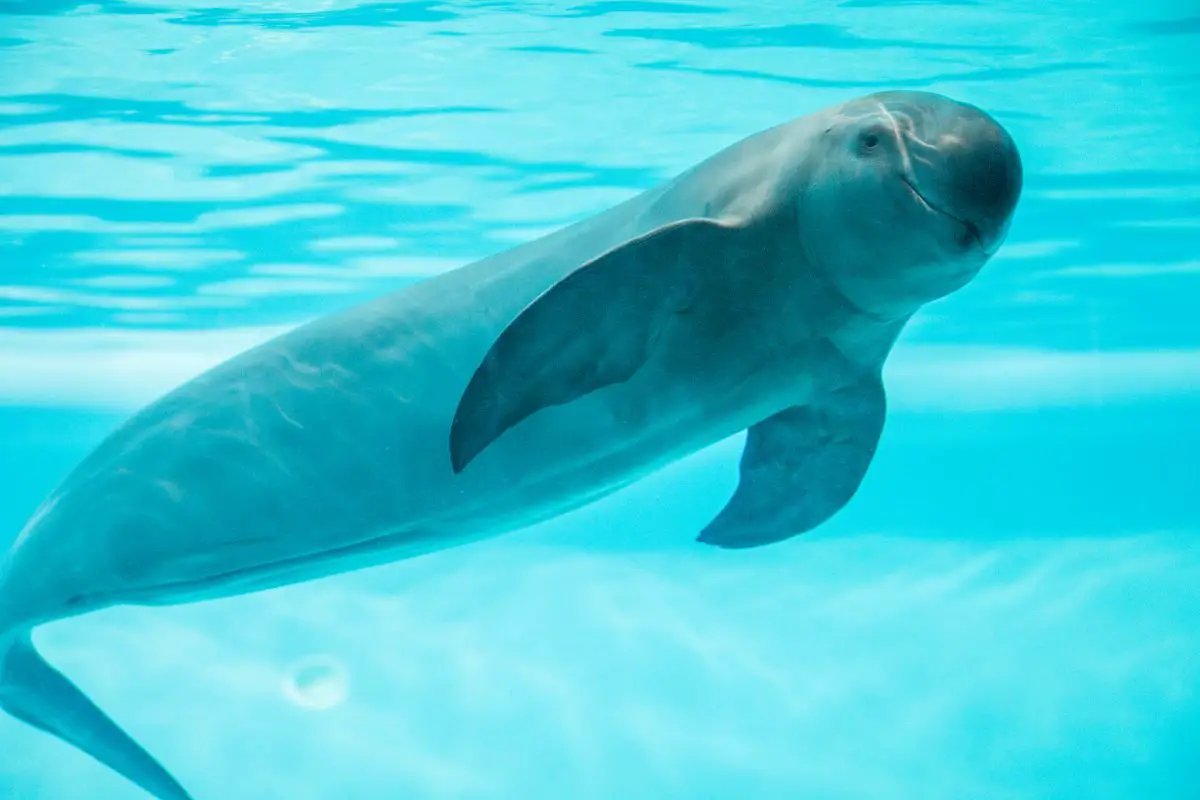
Porpoises are marine mammals found in freshwater rivers, coastal waters, and the ocean. This mammal has a fish diet, but may also eat algae, mollusks, and small squid. The lifespan of the porpoise can vary, but in most cases, it will live for 8 to 10 years in the wild.
There are eight living species of porpoises, and sizes can vary from one species to another. The vaquita is usually about 4’7″ in length, with a weight of 119 pounds. Other species, like the Dall’s porpoise, are much larger, with a typical length of 7’7″ and a weight of 490 pounds.
Porpoises and dolphins communicate with each other through vocalizations and echolocation. Both types of animals have a thick, insulating layer of blubber that can keep them warm in cold water. Porpoises also resemble dolphins and can be mistaken for them at first glance.
Dolphins have a pronounced beak, but porpoises don’t have this feature. Porpoises have flat teeth shaped like spades, while dolphins have conical teeth. Most porpoises have triangular fins, but some species of porpoise don’t have fins at all!
2. Belugas Are Small Whales That Resemble Giant Dolphins!
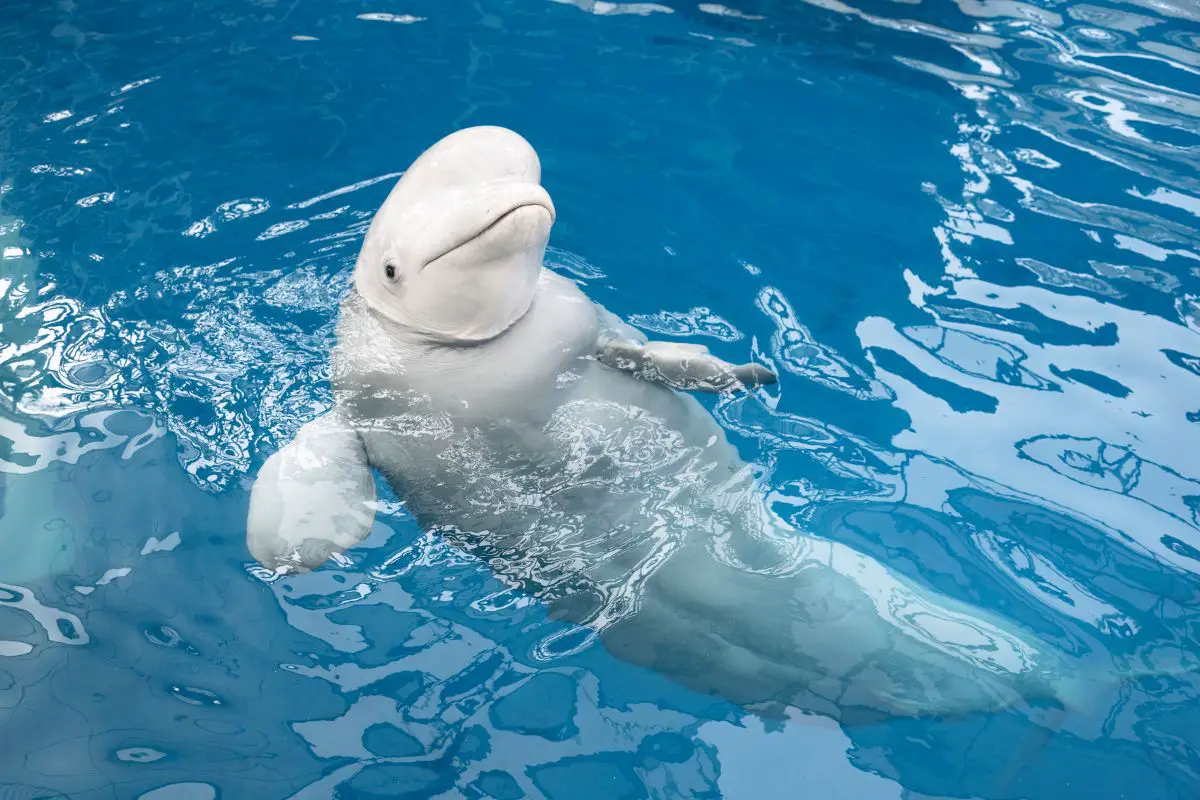
Sometimes called white whales, belugas are smaller that lives in arctic waters. Usually, belugas live near coasts, but they can sometimes be found in deeper waters. Mature belugas are measure between 14 and 18 feet and can weigh as much as 3,000 pounds.
Belugas are opportunistic feeders with a varied diet that includes fish and crabs. They can dive up to 700m below the surface of the water when searching for food. These whales can live for up to 60 years in the wild.
Like dolphins, belugas are social and usually spend time in groups known as pods. Instead of olfactory nerves, both animals have chemoreceptors that help them to detect nearby threats. Belugas and dolphins love to play and often rub against each other.
Belugas may look like dolphins, but they’re larger and don’t have the same long snouts! Also, beluga whales don’t have dorsal fins, which makes it easier for them to swim beneath ice sheets. Dolphins are gray, but beluga whales are stark white.
3. Narwhals Are a Close Relative of Dolphins With Tusks Like Unicorns
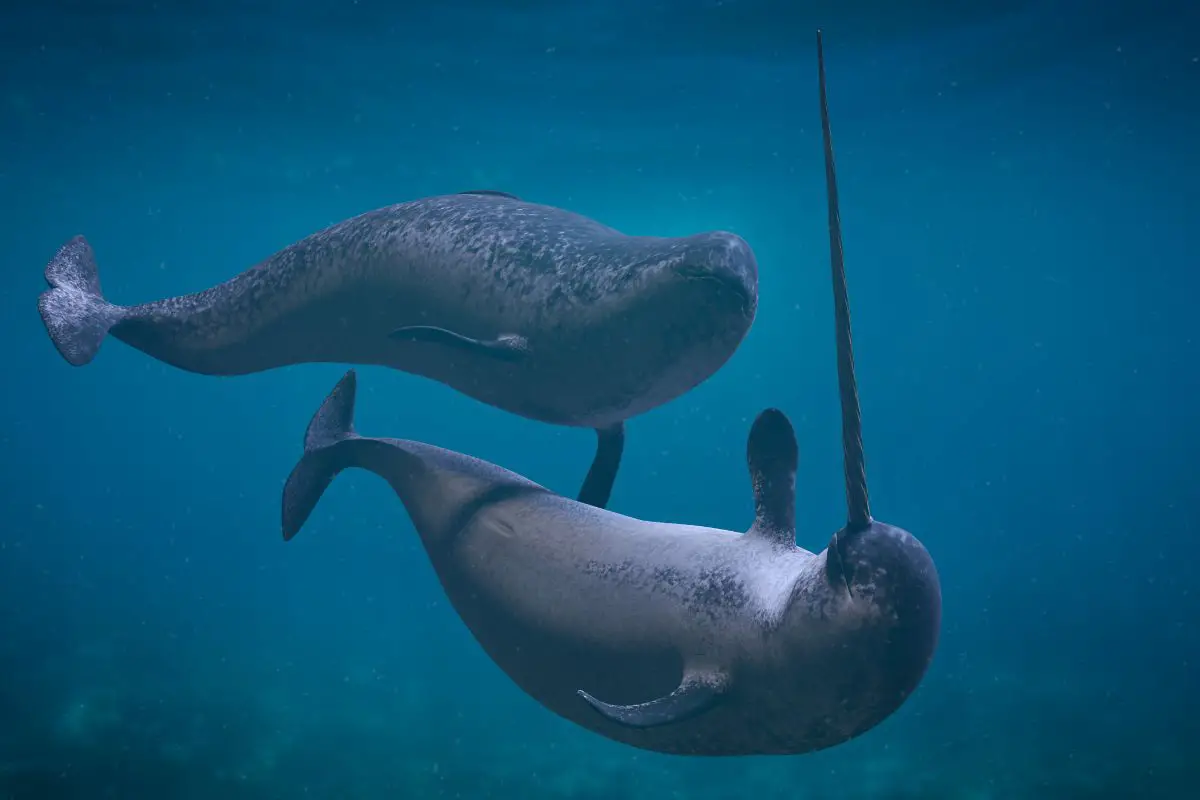
Narwhals are a whale species known for having a long tusk (which is a protruding tooth). These aquatic marine mammals live in Arctic waters around Greenland, Russia, and Canada. They range from 18 to 18 feet long and weigh between 1,760 and 3,350 pounds.
The narwhal is an arctic predator that often feeds on flatfish located beneath flat ice. In warmer weather, narwhals eat fish like cod and halibut. Narwhals can live up to 50 years, but many narwhals suffocate when they’re trapped under ice.
Both narwhals and dolphins have layers of blubber that keep them warm in cold waters. When you spot these animals in the water, you’ll usually see them traveling in small groups! Like dolphins, narwhals communicate through sounds like clicks and knocks.
Even though narwhals do have teeth, you won’t see any teeth in their mouths. Instead, narwhals have teeth on their bodies! Narwhals don’t have dorsal fins, but they do have tail flukes that help them swim through the water.
4. Manatees Are Gentle Mammals That Never Leave the Water
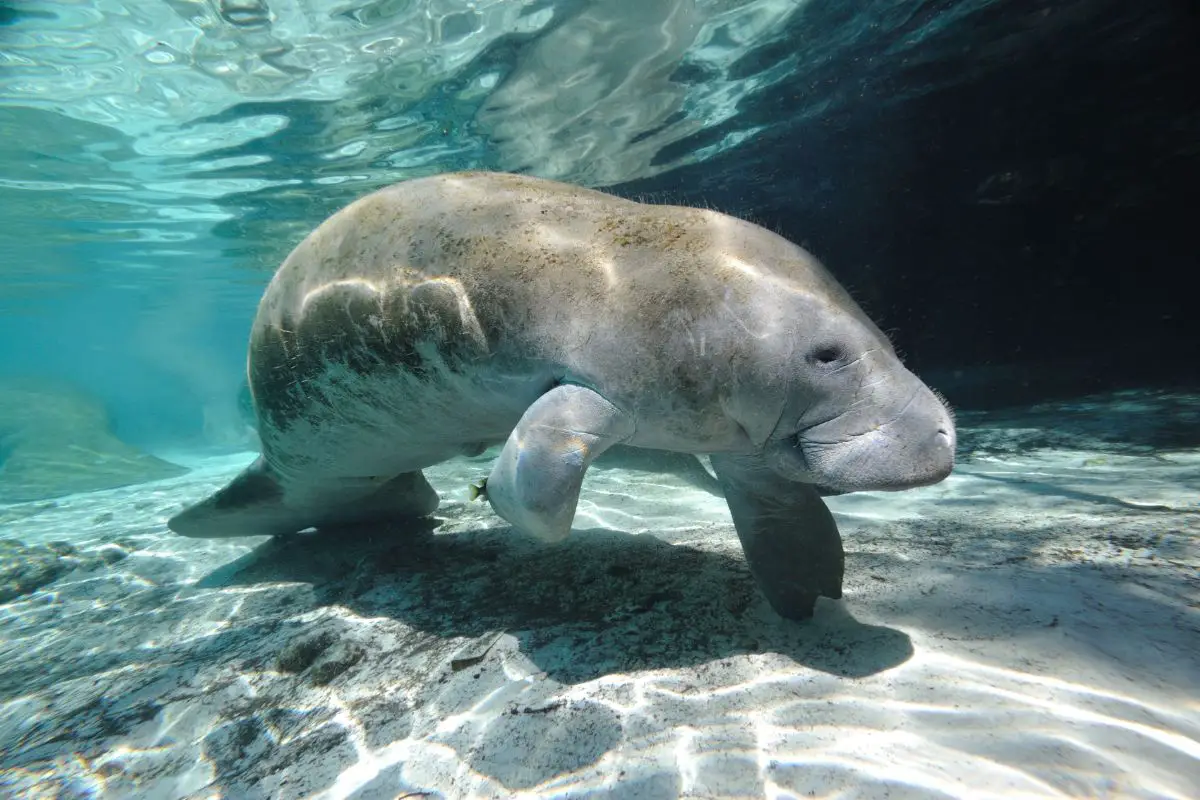
Manatees live in freshwater and saltwater habitats, including rivers near the Caribbean Sea. These mammals have flippers they can use to walk along the bottom of the water and scoop up plants. Even though manatees are herbivores, they sometimes scoop up fish as they eat.
The manatee can grow to be more than 13 feet long and weigh up to 1,300 pounds. They have been known to live for as long as 65 years. Manatees don’t have natural enemies, but they’re sometimes killed by boats and ships.
Since manatees and dolphins are mammals, they must return to the water’s surface to breathe. Most dolphins can stay underwater for 8 to 10 minutes, but manatees can hold their breath for up to 20 minutes! Dolphins and manatees can also produce milk, which they feed their young.
Dolphins and manatees are born with hair, but dolphins lose that hair shortly after birth. Manatees have whiskers and hair all over their body throughout their lives. Dolphins keep the same set of teeth for their entire lives, but manatee teeth are replaced as they age.
5. Beaked Whales Are a Deep-Water Mammal With a Dolphin-Like Bottlenose
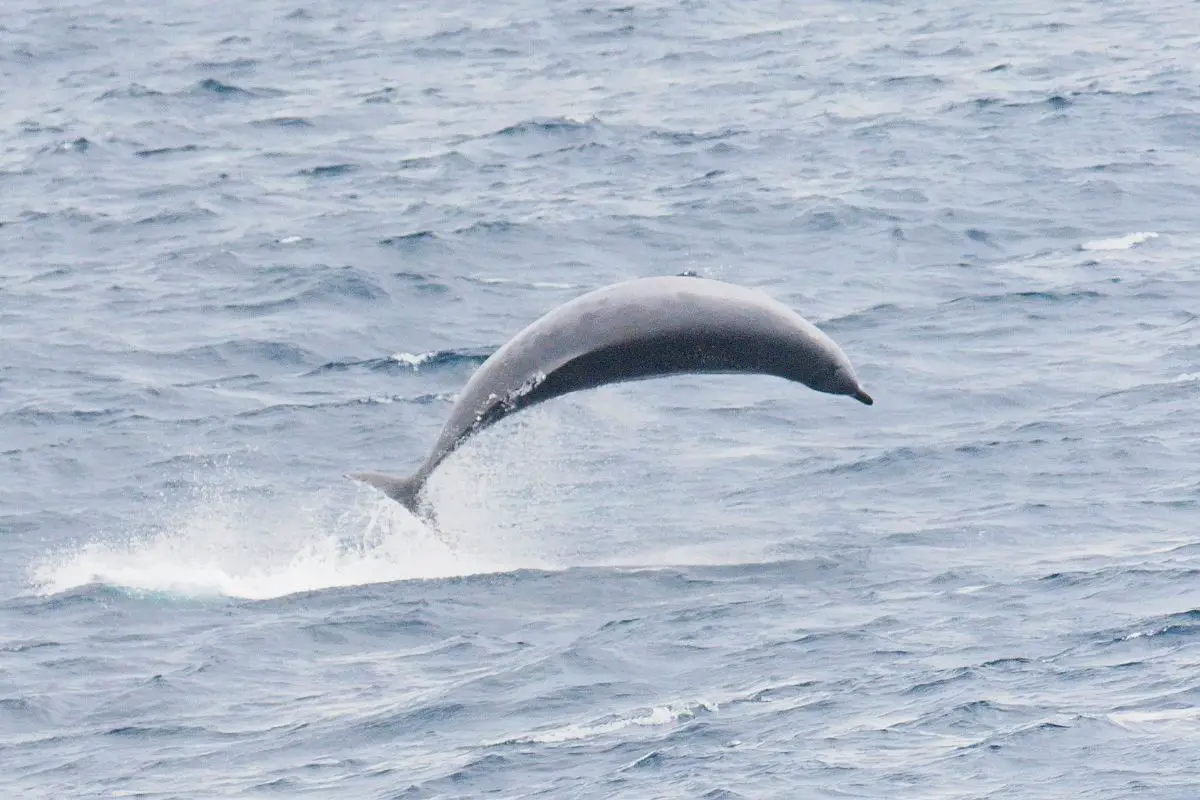
Beaked whales come in various sizes, measuring anywhere from 13 to 43 feet and weighing 2,200 to 33,000 pounds. While there are 24 known species, we don’t know much about them because they live deep beneath the water. They can inhale prey like fish and squid through their oral cavity.
These mammals live worldwide, including waters around the equator and North and South Poles. They congregate in very deep waters, which makes them hard to see. The oldest recorded age for a beaked whale is 84 years.
Dolphins are known for their bottlenose. That long nose can be seen on beaked whale species like the Longman’s beaked whale. Both animals also have bulging foreheads.
Dolphins and beaked whales have blubber, but beaked whale blubber is made of wax ester. Unlike dolphins, beaked whales don’t use their teeth to catch prey. In fact, some experts believe that beaked whale teeth help attract mates!
It’s believed that these whales travel in groups.
6. Dugong Are a Vulnerable Marine Animal With a Superpowered Sense of Touch
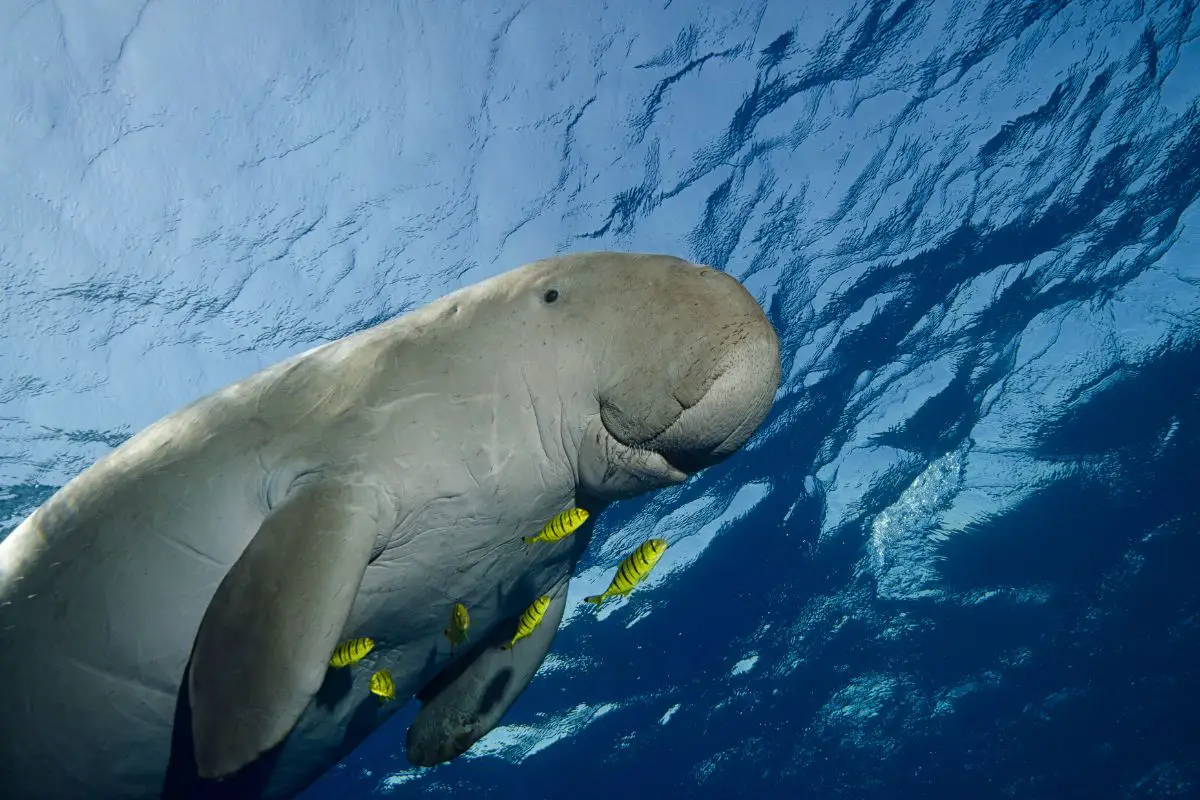
The dugong is a herbivorous marine mammal that’s a close relative of the manatee. Dugong feeds on seagrasses, and because of that, they’re limited to coastal habitats. Most dugongs lives in the waters of Northern Australia, around Moreton and Shark Bay.
Adult dugong measures around 8 feet but can grow as long as 13 feet. Once mature, they can weigh anywhere from 550 to 2,000 pounds. While dugongs are a vulnerable species, they can live for as long as 70 years in the wild.
Dolphins and dugong both have poor vision and a powerful sense of touch. Unlike dolphins, dugongs have a strong sense of smell, which helps them find food sources. Unfortunately, both animals are hunted for blubber, so dugong are at risk today.
Both dolphins and dugong actively parent their young and keep them close. As mammals, both animals feed their young with milk and nurse them for at least the first year of their lives. Dugongs have a dolphin-like tail fluke and two tusks, which can be used to determine the animal’s age.
7. Sharks Are a Predatory Fish With Dorsal Fins
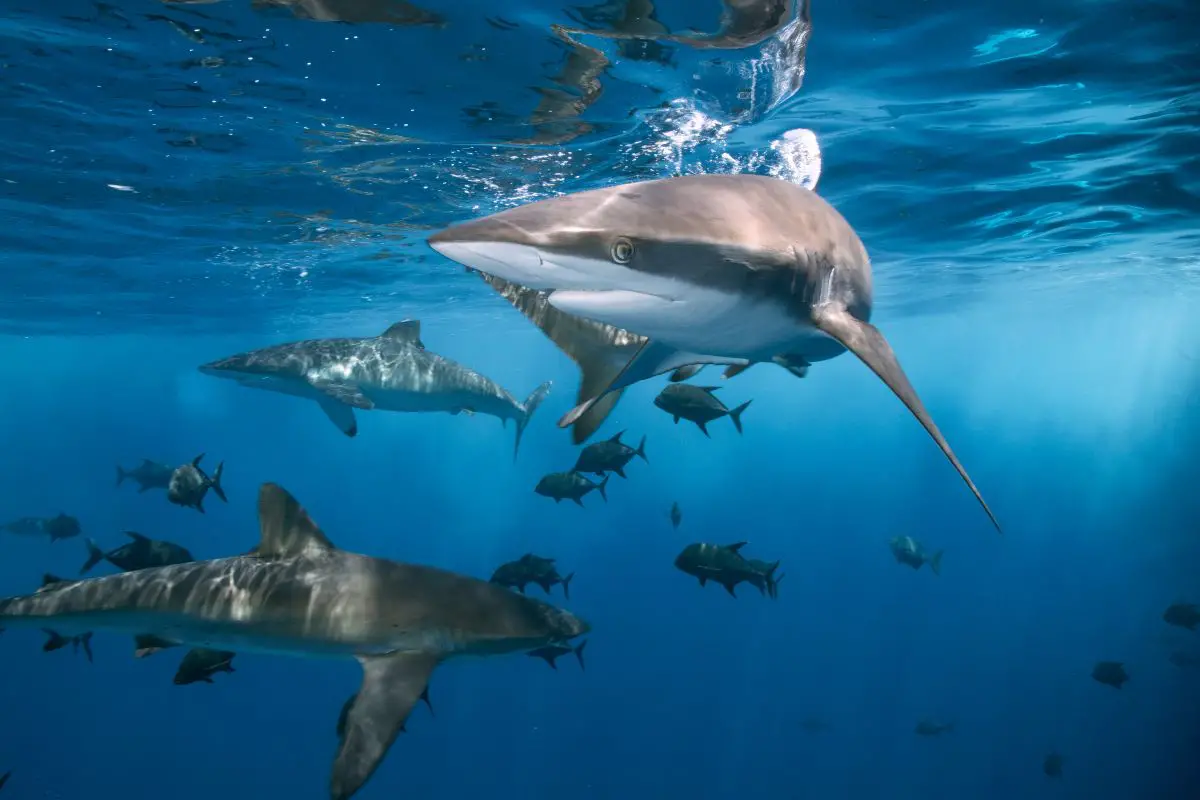
Sharks are a group of fish that includes more than 500 species. While sharks rarely live in freshwater, they can be found in every sea in the world. Sharks are carnivores, and some species, like the tiger shark, are apex predators.
The dwarf lantern shark is the smallest shark species and measures 6 inches long. Whale sharks, which measure up to 40 feet, are the largest fish in the entire world. Sharks can weigh anywhere from 2 to 81,000 pounds depending on the species.
Most sharks live between 20 and 30 years and grow tens of thousands of teeth throughout their lifetime. Even though sharks and fish and dolphins are mammals, the two animals have a lot in common! Both dolphins and sharks have tails, pectoral fins, and dorsal fins on their backs.
When you see a dorsal fin poking out of the water, it can be hard to tell if you’re looking at a shark or a dolphin! Both animals have similar diets, but sharks will sometimes eat marine mammals (or other sharks!) Dolphins breathe air through the blowhole on their head, but sharks have gills.
Unlike dolphins, sharks can’t vocalize, and they tend to be solitary creatures.
8. The Elephantnose Fish Looks Like a Tiny Dolphin!
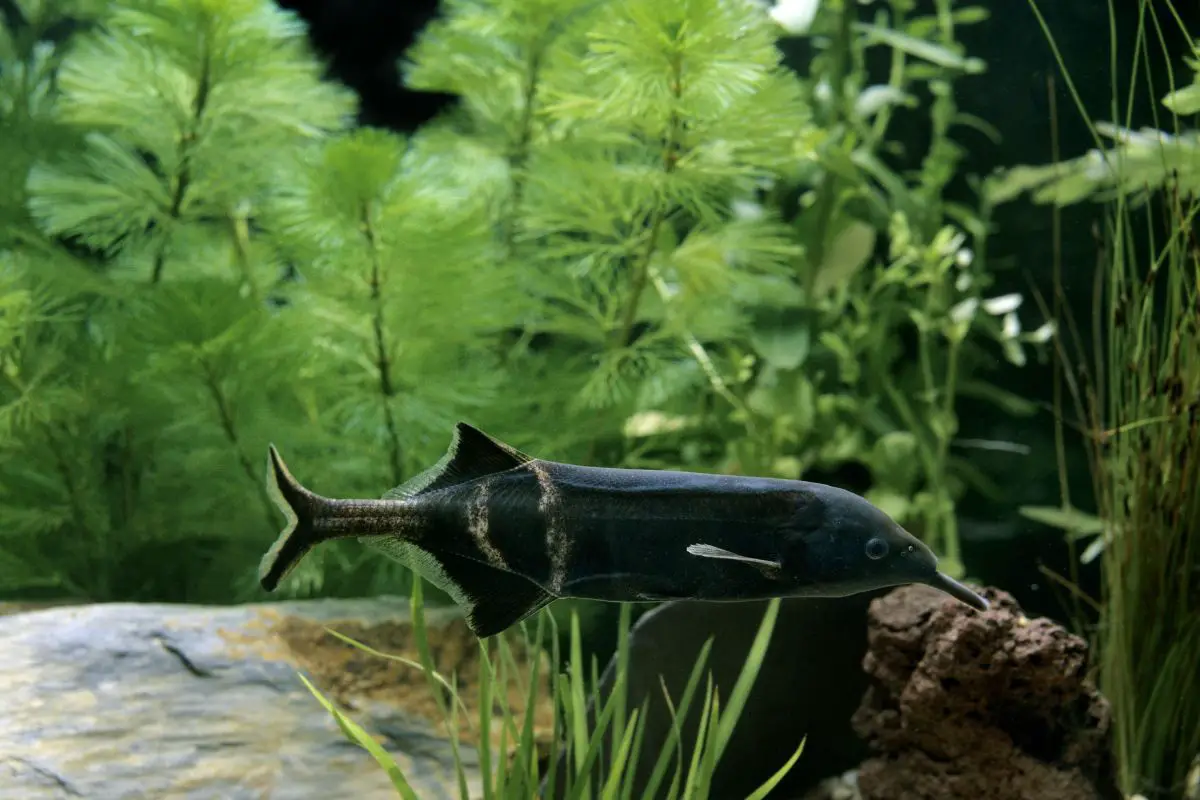
The Elephantnose fish is a freshwater fish found in Central and West African waters. These fish are like muddy rivers, where they feed on worms and insects. It can create electrical fields, which it uses to find food and mates.
These fish are very small, usually measuring around 9 inches in length. Since they’re tiny, they can be kept as aquarium fish, but they’ve never been bred in captivity. Usually, they live between six and ten years, though they can live longer.
Elephant nose fish and dolphins are different, but they have some things in common! The Elephantnose has a long trunk that resembles the bottlenose of a dolphin. This isn’t actually a nose at all, but a part of the fish’s mouth that it uses for communication and self-defense.
Elephant nose fish also have dorsal fins and a forked tail fin. They spend most of their time in murky waters, where they rarely see other fish of their species. When fish are kept together in tanks, they often become aggressive towards each other.
9. Pygmy Sperm Whales Are Dolphin-Sized Whales
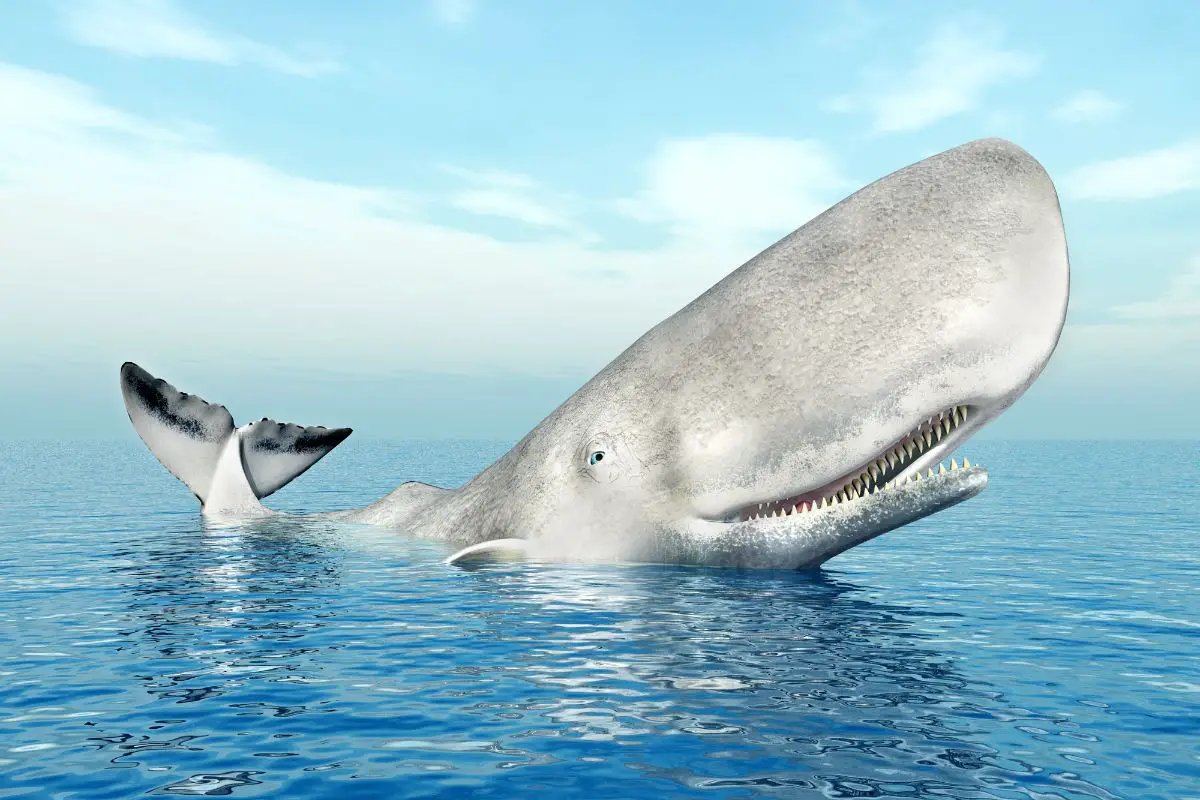
Sometimes called dwarf sperm whales, these small whales usually measure around 7 feet and weigh between 400 and 940 pounds. They can be found in the waters around the Pacific, Atlantic, and Indian Oceans. These whales feed on octopuses and squid but may also eat deep-sea shrimp species.
These aquatic mammals like swimming deep beneath the water’s surface. It’s rare to see these whales in the water, but they may have contact with humans if they become stranded on shore. Pygmy dolphin whales live between 18 and 25 years.
Like dolphins, dwarf sperm whales can use echolocation to find prey in the waters around them. While they’re less social than dolphins, they still communicate through clicks. They also have a body of fat on their head, which they use to modulate their sounds.
Thanks to a mutation, dwarf sperm whales usually don’t have enamel on their teeth. They have fewer neurons in their brain, which may be why they have less complex social interactions than dolphins. When they’re frightened or cornered by predators, they can expel bright red fluid.
10. Dolphinfish and Dolphins Share a Name and Other Characteristics!
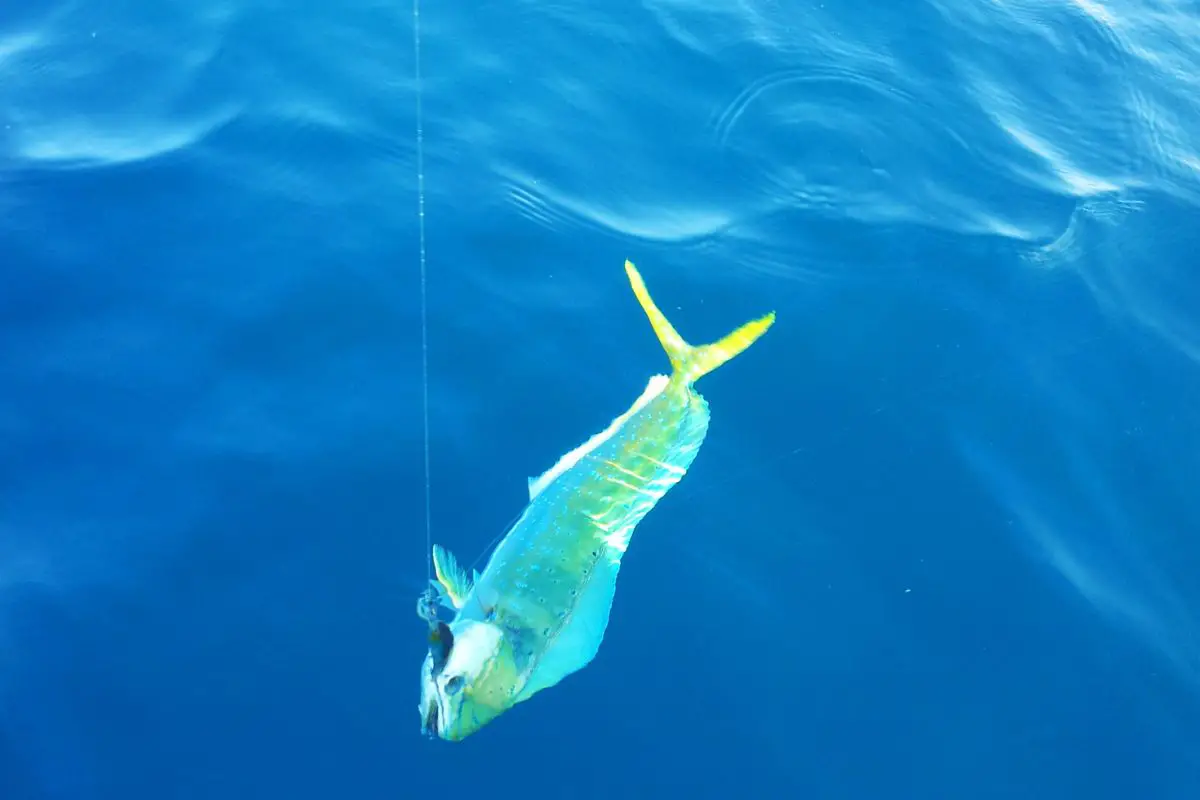
Dolphinfish are carnivorous fish found in the coastal waters of South America. Despite their name, these fish have no relation to dolphins. They have dazzling colors on their scales, such as rich gold and bright shades of teal and blue.
For the most part, dolphinfish feed on smaller fish, though they may also eat small squid species. Pompano dolphinfish can measure up to 50 inches but usually doesn’t grow any larger than 20 to 24 inches. Mahi-Mahi is typically larger, measuring between 2’8″ and 4’6″ and weighing up to 50 pounds.
Originally, dolphinfish were called dolphins, not dolphinfish. They both communicate with each other through high-pitched sounds. The animals also have a similar body shape and diet.
Different species that live in the same environment can develop similar traits. This may be what happened to dolphinfish and dolphins! These animals have a lot in common, but no one will mistake a gray dolphin for a colorful dolphinfish.
FAQ
Did Dolphins Evolve from Land Animals?
Dolphins spend their lives in the water, but they evolved from a land animal called the pakicetus. It was a wolf-like animal that lived near the water, feeding on small animals and fish.
What Animals Share a Common Ancestor With Dolphins?
Dolphins and hippos don’t look much alike, but they’re relatives of the pakicetus. Other animals that descended from the pakicetus include antelopes, deer, and even giraffes!
What Do Dolphins and Humans Have In Common?
Dolphins and humans share a surprising number of traits! Like humans, dolphins are curious and highly sociable. Dolphins also love to play with each other and will even play with humans!
